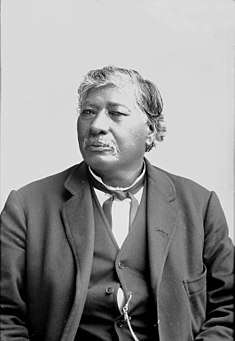Seminole in the American Civil War
The Seminole in the American Civil War were found in both the Trans-Mississippi and Western Theaters. The Seminole Nation in the Trans-Mississippi Theater had split alliances with some fighting for the Union and others supporting the Confederacy. The Florida Seminole participated in some skirmishing in central Florida.[1] They were likely at the Battle of Olustee in February 1864.

Trans-Mississippi Theater
In the Trans-Mississippi Theater, the Seminole Nation was led by John Jumper. Jumper's Seminole name was "Hemha Micco." He was commissioned in the Confederacy as a major, lieutenant colonel, and colonel. He was in the battles of Round Mountain, Chusto-Talasah, Middle Boggy, and Second Cabin Creek.
First Seminole Battalion (Mounted Volunteers)
The First Seminole Battalion was organized on September 21, 1861.
First Seminole Regiment (Mounted Volunteers)
The First Seminole Battalion re-organized as the 1st Seminole Regiment on July 1, 1864.
Organization
The Seminole Nation organized into companies, battalions, and regiments.
- First Seminole Battalion (Mounted Volunteers)
- Field & Staff: Major John Jumper
- Companies: Company A (Captain George Cloud) and Company B (Captain Fushatchie Cochokna)
- First Seminole Regiment (Mounted Volunteers)
- Field & Staff: Colonel John Jumper, Major George Cloud, Charles C. Dyer (A.Q.M.), D. R. Patterson (Adjutant), W. W. Burnes ( Assistant Surgeon), Hu McDonald (A.Q.M.)
- Companies: Company A (Captain Thomas Cloud), Company B (Captain Fushatchie Cochokna), Company C (Captain James Factor), Company D (Captain Tustanucogee), Company E (Captain Sam Hill), and Company F (Captain Osuchee Harjo)
Western Theater
In Florida, two distinct companies were raised who had Seminole Indians as members of the Confederate Army. Andrew E. Hodges, a white man who lived on the coast near Cedar Key, raised a company of Indian sharp shooters starting in 1862.[1] Hodges' Company not only had Seminole Indians but whites, Hispanics, blacks, and other tribal members in his unit.[1] Seminoles may have played a sharp shooter role at the Battle of Olustee. By July 1864, Hodges had passed his company to Andrew M. McBride. McBride was elected captain and wrote Secretary of War James A. Seddon that the company was ready for service.[2]
"Several paragraphs having gone the rounds recently that the Seminoles remaining in Florida had recently committed murders and depredations on white families in South Florida, we take pleasure in stating, on the authority of an officer who had just returned from that region, that they are perfectly quite, and have not been guilty of any outrages. They now number about eighty fine warriors, and their chief has called them all in to the interior from the coast for fear they will be tampered with by our enemies. They are desirous of entering the Confederate service, and will soon be organized into a company and armed. Our old friend, Col. H. V. Snell, who is a great favorite with them, will probably be most effectually and faithfully attended to. When they do find a Yankee intruder, or a Thayer colonist, he will receive his perpetual pre-emption to Florida soil. They are a remnant of a small tribe of brave Seminoles, against the armies of the United States, led by Scott, the best general in the service, during a period of over seven years, and were never completely subjugated. They will prove to be most valuable allies. They will protect a long line of the Florida coast, and will be a terror to Yankee invaders. They should henceforth be cherished and protected by the Confederacy, and a home in perpetuity should be laid off for them in South Florida."
— The Weekly Advertiser, The Florida Indians, November 5, 1862[3]
Hodges' Company
At the opening of the Civil War, Andrew E. Hodges was living near Cedar Key, Florida.[1] In 1862, he was part of a home guard that navigated the waterways and coasts. Later that year he raised a company of sharp shooters.
McBride's Company
McBride had mustered 65 individuals on July 7, 1864 at Everglades, Florida. On the muster roll the following was declared, "We, the undersigned, respectfully volunteer and tender our services to the Confederate States of America, begging to be immediately admitted into their armies, having chosen A. McBride for our Captain."[1]
Organization
- Hodges' Company (organizational life: 1862-July 1864)
- Company (Andrew E. Hodges)
- McBride's Company (organizational life: July 1864 – 1865)
- Company (Captain Andrew M. McBride)
- Total: 65 men
Battles
"The most desperate enemy that we have to contend with here is the Florida Indians, who have organized themselves into roving bands of bushwhackers and occasionally steal upon our picket lines under cover of night and disturb our sentinels. Many of the Redskins are sharp-shooters. During the recent battle, they betook themselves to the tree-tops and picked off many of the officers of the Colored Troops."
— Frederick F. French, Letter to Thomas F. Kelly of Glens Falls, New York, March 6, 1864[4]
Aftermath
Trans-Mississippi Theater
Reconstruction was a particularly harsh for the Indian nations found west of the Mississippi.
Western Theater
After the War ended, the Seminole Indians became reclusive, and their history was obscured. Florida's Seminole Indians continue to live in and around the everglades.
Both Andrew E. Hodges and Andrew M. McBride survived the War. They lived out the remainder of their lives in Florida.
See also
External links
References
- Ferguson, Robert. "Southeastern Indians During The Civil War". The Backwoodsman. Vol. 39 no. 2 (Mar/Apr 2018 ed.). Bandera, Texas: Charlie Richie Sr. pp. 63–65. Retrieved February 19, 2018.
- Robert A., Taylor (January 1991). "Unforgotten Threat: Florida Seminoles in the Civil War". The Florida Historical Quarterly. 69 (3): 300–314. Retrieved August 30, 2017.
- "The Florida Indians". The Weekly Advertiser. November 5, 1862.
- Wiezbicki, Steven M. (2014-04-01). "169th New York Infantry Newsletter" (PDF). Retrieved 2018-01-27.